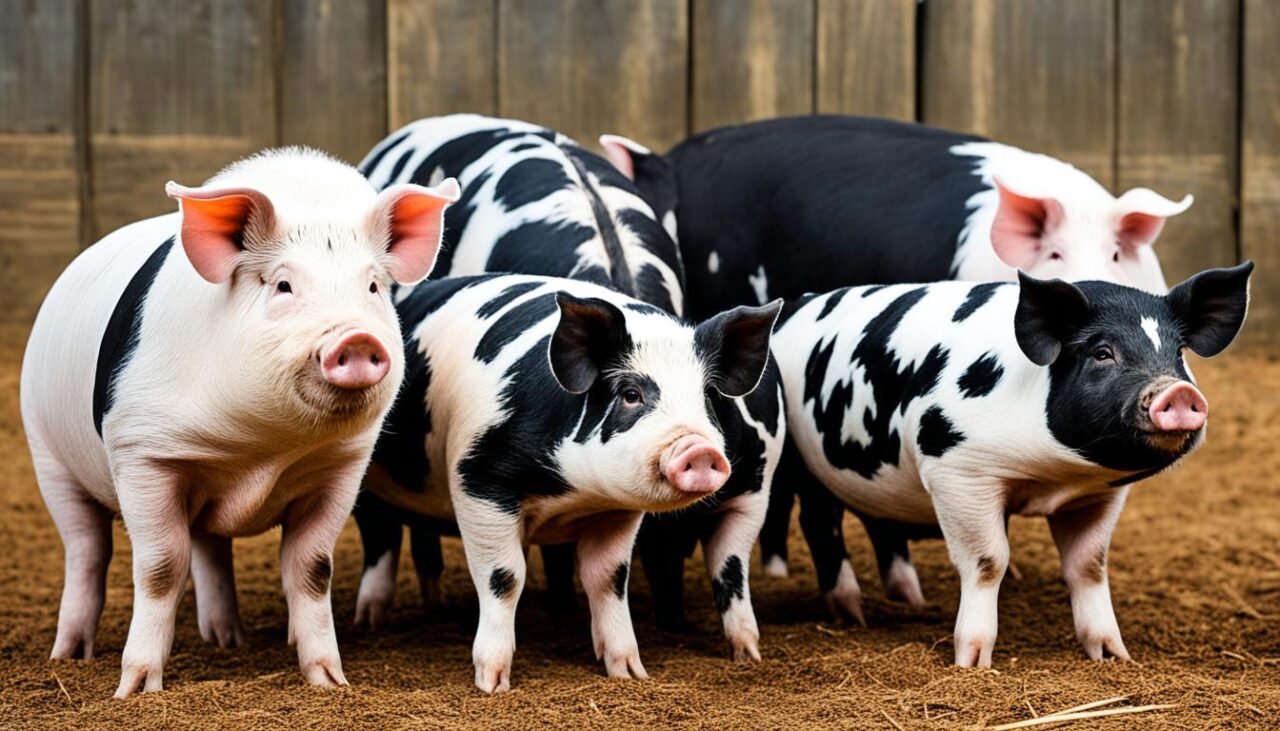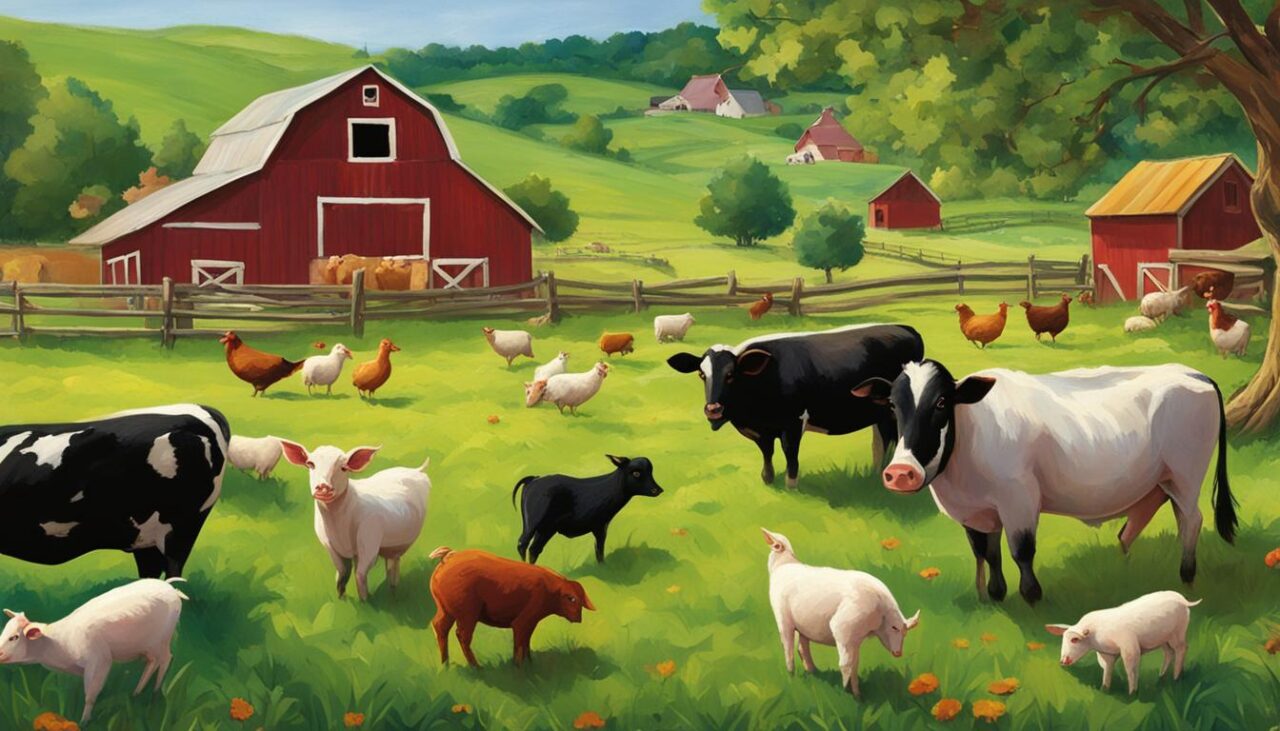Welcome to the world of sustainable farming, where farm animal diversity is the key to maintaining a healthy and thriving environment. From pigs to chickens, to cows, each animal has a unique role to play on the farm and contributes to the success of sustainable agriculture.
Whether you're new to farm life or a seasoned farmer, understanding the importance of animal welfare and livestock management is crucial to maintain a diverse and sustainable farm animal population. Join us on a journey to explore the world of farm animal diversity and discover how it contributes to our overall wellbeing.
Before we delve deeper into the topic, let's take a moment to appreciate the beauty of farm animals with this image:
- 1 Key Takeaways:
- 2 Exploring Pig Breeds: From the Spotted Gloucestershire to the Majestic Berkshire
- 3 Barnyard Companions: From Clucking Chickens to Contented Cows
- 4 Sustainable Animal Farming: Preserving Diversity for Future Generations
- 5 Ensuring Animal Welfare: A Key Factor in Farming Diversity
- 6 Livestock Management: Balancing Diversity and Efficiency
- 7 Conclusion
Key Takeaways:
- Farm animal diversity is crucial for sustainable farming and a healthy environment.
- Animal welfare and livestock management play a crucial role in maintaining diverse farm animal populations.
- Chickens, cows, and other barnyard animals also contribute significantly to the farm's success.
- Preserving farm animal diversity ensures a healthy animal population for future generations.
- Balancing diversity with efficiency is crucial for smooth livestock management.
Exploring Pig Breeds: From the Spotted Gloucestershire to the Majestic Berkshire
When it comes to farm animal diversity, pigs are some of the most fascinating creatures around. From their curly tails to their oink-worthy snouts, these animals have captured our hearts and plates alike for centuries. But did you know that there are actually a wide variety of pig breeds found on farms all over the world? Let's take a look at just a few examples!

The Spotted Gloucestershire
This breed of pig is instantly recognizable thanks to its striking black and white spots. Known for their friendly disposition and tender meat, this breed has been a staple on British farms for centuries. In fact, the Gloucestershire Old Spots is one of the most critically endangered pig breeds in the world, making their preservation all the more important for farm animal diversity!
The Majestic Berkshire
Also known as the Kurobuta, this breed of pig originated in Japan and is instantly recognizable thanks to its dark, almost black coat. But don't let the color fool you – these pigs are known for their high-quality, succulent meat and are a favorite among chefs and foodies alike. With their beautiful appearance and delicious flavor, it's no wonder that the Berkshire is one of the most popular pig breeds around!
Fun fact: Did you know that pigs are incredibly intelligent animals? In fact, some studies have shown that they may even be smarter than dogs!
These are just a few examples of the many pig breeds available on farms. Each breed has its own unique traits and characteristics, making them valuable additions to the world of farm animal diversity!
Barnyard Companions: From Clucking Chickens to Contented Cows
When we think of farm animals, our minds immediately go to the adorable portly pigs snuffling in the mud. But farm animal diversity goes far beyond our rotund friends. From clucking chickens to contented cows, each animal has its place on the farm and contributes to the overall ecosystem.
Not only do these barnyard companions add to the visual appeal of the farm, but they also have their unique jobs and purposes. Chickens are fantastic at pest control and provide delicious eggs for breakfast. Cows, on the other hand, give us milk and cheese, and, let's not forget, are responsible for some of the tastiest burgers out there.

But it's not just about what they offer us; farm animal diversity ensures a healthy and sustainable ecosystem. Each animal's waste is used to fertilize fields, promoting healthy soil. They graze on different areas of land, reducing the chance of overgrazing in one spot. By having a diverse range of animals on the farm, we can mimic the natural environment and ensure everything thrives.
Sustainable Animal Farming: Preserving Diversity for Future Generations
When it comes to farm animal diversity, sustainability is key! Preserving the diversity of farm animals isn't just important for present-day farmers, but also for the generations to come. By focusing on sustainable farming practices, farmers can ensure that they are not just making the most of every animal, but also preserving a diverse and healthy animal population for the future.
One key aspect of sustainable farming is proper livestock management. By maintaining a balanced mix of animals, farmers can help reduce the risk of disease outbreaks while ensuring that they have enough animals to meet their needs. Farms should also commit to using sustainable agricultural practices, like rotational grazing, which can help keep soil healthy and reduce the environmental impact of farming.
But sustainable farming isn't just about land and animal management. It's also about ensuring that the welfare of the animals comes first. When animals are treated fairly and humanely, they are more likely to thrive, reproduce, and ultimately contribute to a healthy animal population. To that end, farmers should work to provide a comfortable, stress-free environment for their animals while avoiding inhumane practices like overcrowding or the use of harmful growth hormones.
“In the end, sustainable farming isn't just about growing crops or raising animals – it's about preserving a way of life for future generations.”
By following these sustainable farming practices and prioritizing animal welfare, farmers can ensure that diversity continues to thrive in the barnyard. And, with a little creativity, farmers can even find ways to use diversity to their advantage, such as by raising heritage breed animals that are perfectly suited for their local environment.
Ultimately, sustainable animal farming is about balance: balancing the needs of the environment, the animals, and the people that rely on the farm for their livelihood. By preserving a diverse range of animals, farmers can ensure that the needs of both present and future generations are met – now that's good farming!
Ensuring Animal Welfare: A Key Factor in Farming Diversity
At the heart of every successful and sustainable farming operation is a deep commitment to animal welfare. The ethical treatment of farm animals not only ensures their well-being but also contributes to the preservation of farm animal diversity. It is a key factor in the success of farming operations and the satisfaction of consumers.
Practices that promote animal welfare include providing proper nutrition, clean water, and adequate space. Farmers should ensure the animals have access to a comfortable living space and environment that supports their natural behavior and instincts. By prioritizing animal welfare, farmers can help maintain a diverse population of healthy, thriving animals.

“The greatness of a nation and its moral progress can be judged by the way its animals are treated.” – Mahatma Gandhi
It is also important to recognize that animal welfare extends beyond the physical well-being of the animal. Emotional and mental states are equally important aspects of a farm animal's welfare. Creating an environment where animals feel safe, comfortable, and free from stress is crucial in maintaining diversity on the farm.
Ultimately, animal welfare is an integral part of maintaining farm animal diversity. By promoting ethical practices that prioritize the well-being of farm animals, we can ensure the animals thrive and contribute to the success of our farming operations.
Livestock Management: Balancing Diversity and Efficiency
Managing a diverse livestock population is no small feat. It requires a delicate balance between maintaining optimal animal health and welfare, and maximizing productivity. But fear not! With the right strategies and tools, you can successfully manage your farm animal diversity while ensuring efficiency.
One key aspect of livestock management is tracking animal health records and performance metrics. This helps identify any health or productivity issues early on, allowing you to take corrective measures before they become bigger problems. Additionally, regular check-ups and vaccinations can prevent the spread of diseases and ensure optimal animal health.
Another strategy is to group animals based on their specific needs and characteristics. For example, separating animals by age, size, and gender can optimize feeding regimes and minimize aggression. This can lead to improved animal performance and overall operational efficiency.
However, to achieve long-term success in livestock management, it is important to prioritize animal welfare and respect the individual needs of each animal. This means providing adequate space, ventilation, and access to food and water, as well as minimizing stress-inducing interventions.
At the end of the day, managing a diverse livestock population requires a careful balance of efficiency and animal welfare. By implementing best management practices and prioritizing the health and well-being of your animals, you can create a thriving and sustainable farm.
Conclusion
In conclusion, it is evident that farm animal diversity plays a crucial role in sustainable farming practices. The diversity of breeds and species on the farm not only contributes to the welfare of animals but also helps to create a healthy ecosystem.
Proper animal welfare practices should be a priority, and livestock management strategies should aim to balance diversity with efficiency.
Maintaining farm animal diversity requires a dedication to preserving these breeds for future generations. Through sustainable farming practices, farmers can ensure that their animals live in optimal conditions while supporting the health of the planet.
Ultimately, farm life is enriched by the diversity of animals on the farm, and it is essential that we continue to support and preserve this diversity.
Thank you for taking the time to explore the role of farm animal diversity in sustainable farming, animal welfare, and livestock management.
Contents
- 1 Exploring Pig Breeds: From the Spotted Gloucestershire to the Majestic Berkshire
- 2 Barnyard Companions: From Clucking Chickens to Contented Cows
- 3 Sustainable Animal Farming: Preserving Diversity for Future Generations
- 4 Ensuring Animal Welfare: A Key Factor in Farming Diversity
- 5 Livestock Management: Balancing Diversity and Efficiency
- 6 Conclusion







